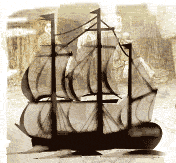PART ONE - WORKPLACES
|
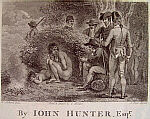 Visiting the sick (1789). A party including John White (the
principal surgeon), George Worgan (surgeon of the "Sirius"),
and Governor Phillip, is shown here visiting a young aboriginal
woman, who is recovering from an illness. One of the men is
offering her a fish to eat. From An historical
journal of the transactions at Port Jackson and Norfolk Island
by John Hunter. London : Stockdale, 1793.
Visiting the sick (1789). A party including John White (the
principal surgeon), George Worgan (surgeon of the "Sirius"),
and Governor Phillip, is shown here visiting a young aboriginal
woman, who is recovering from an illness. One of the men is
offering her a fish to eat. From An historical
journal of the transactions at Port Jackson and Norfolk Island
by John Hunter. London : Stockdale, 1793.
Reproduced by courtesy of the
Rare Books Collection, State Library of Victoria
|
 Bussorah Merchant, an emigrant ship, painted by David Little.
On her voyage to Australia in 1837 with 293 immigrants under
Surgeon M. Price RN, there were 58 deaths. On her voyage in
1850, with 246 immigrants under Surgeon Superintendent J.D.Tweeddale
MRCS, there were 9 deaths. These figures possibly reflect a
general improvement in the calibre of ship's surgeons, as well
as improved health regulations on immigrant ships.
Bussorah Merchant, an emigrant ship, painted by David Little.
On her voyage to Australia in 1837 with 293 immigrants under
Surgeon M. Price RN, there were 58 deaths. On her voyage in
1850, with 246 immigrants under Surgeon Superintendent J.D.Tweeddale
MRCS, there were 9 deaths. These figures possibly reflect a
general improvement in the calibre of ship's surgeons, as well
as improved health regulations on immigrant ships.
Reproduced by courtesy of the La
Trobe Picture Collection, State Library of Victoria
|
tp.JPG) Marco
Polo, which made a record time of 78 days with 940 persons from
Liverpool to Melbourne in 1852. She carried a Surgeon Superintendent
(Dr. J. B. North) and an Assistant Surgeon (Dr. J. T. Graham).
There were 52 deaths on the voyage, nearly all of children under
four. Twenty children died from measles during an epidemic on
the ship. Marco
Polo, which made a record time of 78 days with 940 persons from
Liverpool to Melbourne in 1852. She carried a Surgeon Superintendent
(Dr. J. B. North) and an Assistant Surgeon (Dr. J. T. Graham).
There were 52 deaths on the voyage, nearly all of children under
four. Twenty children died from measles during an epidemic on
the ship.
Reproduced by courtesy of the La
Trobe Picture Collection, State Library of Victoria
|
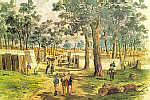 Eaglehawk
Gully 1852 by S.T.Gill, showing the tent of Dr. Bell on the
right. Eaglehawk
Gully 1852 by S.T.Gill, showing the tent of Dr. Bell on the
right.
Reproduced by courtesy of the La
Trobe Picture Collection, State Library of Victoria
|
 Dr. Smith, somewhere in Victoria, showed the true pioneering
spirit, although his accommodation was not typical of the colonial
doctor's residence.
Dr. Smith, somewhere in Victoria, showed the true pioneering
spirit, although his accommodation was not typical of the colonial
doctor's residence.
Reproduced by courtesy of the
La Trobe Picture Collection, State Library of Victoria
|
Doctors could often be consulted
at chemists shops in country towns. A doctor who visited several
towns in a weekly cycle, for example, would advertise that he
could be consulted at the local chemist shop, on (say) Tuesdays.
|
 Chemist
and Druggist at Home Rule, NSW. Dr. Kelly's "plate"
is on the right of the doorway (about 1870) Chemist
and Druggist at Home Rule, NSW. Dr. Kelly's "plate"
is on the right of the doorway (about 1870)
Reproduced by courtesy
of the Mitchell Library, State Library of New South Wales
|
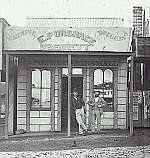 Dr. Bennett has his name in the window of Edward Purchase's
chemist shop in Gulgong, NSW (about 1870)
Dr. Bennett has his name in the window of Edward Purchase's
chemist shop in Gulgong, NSW (about 1870)
Reproduced by courtesy
of the Mitchell Library, State Library of New South Wales
|
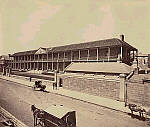 Sydney Infirmary. This building (pictured here in 1870) was
opened in 1816 to replace the old hospital accommodation at
Dawes Point. It was known as the "Rum Hospital", because
it was constructed by a contractor whose payment took the form
of a license to import spirits. The Sydney Infirmary of colonial
times was the predecessor of the modern Sydney Hospital, and
the direct descendent of the first hospital at Sydney Cove (1788).
Sydney Infirmary. This building (pictured here in 1870) was
opened in 1816 to replace the old hospital accommodation at
Dawes Point. It was known as the "Rum Hospital", because
it was constructed by a contractor whose payment took the form
of a license to import spirits. The Sydney Infirmary of colonial
times was the predecessor of the modern Sydney Hospital, and
the direct descendent of the first hospital at Sydney Cove (1788).
Reproduced by courtesy of the
Mitchell Library, State Library of New South Wales
|
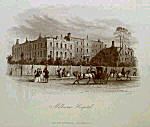 The Melbourne Hospital (est. 1846) is pictured here in 1862.
Reproduced from a steel engraving by Arthur Willmore, from the
original by S. T. Gill
The Melbourne Hospital (est. 1846) is pictured here in 1862.
Reproduced from a steel engraving by Arthur Willmore, from the
original by S. T. Gill
Reproduced by courtesy of the Rare
Books Collection, State Library of Victoria
|
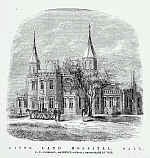 Gippsland Hospital, Sale, in 1867. The popular and romantic
neo-gothic style was used for a number of hospitals of the period.
Reproduced from a wood engraving by Frederick Gosse, based a
photograph by William Vize.
Gippsland Hospital, Sale, in 1867. The popular and romantic
neo-gothic style was used for a number of hospitals of the period.
Reproduced from a wood engraving by Frederick Gosse, based a
photograph by William Vize.
Reproduced by courtesy of the La
Trobe Picture Collection, State Library of Victoria
|
| |
|
|
PART TWO - SOME MEDICAL "TYPES"
|
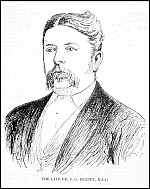 James George Beaney (1828-1891), a colonial surgeon, medical
writer, and philanthropist, was one of a number of pioneer doctors
who became members of parliament
James George Beaney (1828-1891), a colonial surgeon, medical
writer, and philanthropist, was one of a number of pioneer doctors
who became members of parliament
Reproduced by courtesy of the La
Trobe Picture Collection, State Library of Victoria
|
 Dr. J. P. Ryan was one of many who served in Australian colonial
military units, in the volunteer militia or the regular army.
He had served in the French army in the Franco-Prussian war,
and was made a Chevalier de la Légion d'Honneur. He was
a Major in the regular army in Australia.
Dr. J. P. Ryan was one of many who served in Australian colonial
military units, in the volunteer militia or the regular army.
He had served in the French army in the Franco-Prussian war,
and was made a Chevalier de la Légion d'Honneur. He was
a Major in the regular army in Australia.
Reproduced by courtesy of the La
Trobe Picture Collection, State Library of Victoria
|
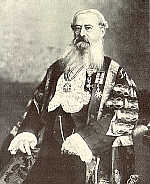 A
colonial medical educator. Dr. (later Sir) Anthony Colling Brownless
(1817-1897), founder of the Melbourne Medical School, came out
from London 1852. He is pictured here in his finery as Chancellor
of the University. Reproduced from University of Melbourne Medical
School Jubilee, Melbourne : Ford, 1914 A
colonial medical educator. Dr. (later Sir) Anthony Colling Brownless
(1817-1897), founder of the Melbourne Medical School, came out
from London 1852. He is pictured here in his finery as Chancellor
of the University. Reproduced from University of Melbourne Medical
School Jubilee, Melbourne : Ford, 1914 |
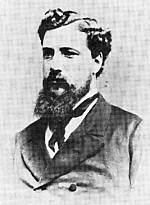 A colonial medical student. Patrick Moloney (1843-1904) was
one of the first two graduates from the Melbourne Medical School
(1867). A popular physician and writer in his own time, he is
still known for his accomplished poetry.
A colonial medical student. Patrick Moloney (1843-1904) was
one of the first two graduates from the Melbourne Medical School
(1867). A popular physician and writer in his own time, he is
still known for his accomplished poetry. |
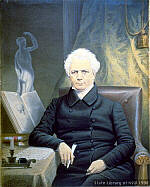 A convict doctor. William Bland (1789-1868), formerly a naval
surgeon, was transported for seven years for murder. He received
a pardon, and became the first full-time private practitioner
in New South Wales. He was a prominent figure in the early political
and medical life of the colony.
A convict doctor. William Bland (1789-1868), formerly a naval
surgeon, was transported for seven years for murder. He received
a pardon, and became the first full-time private practitioner
in New South Wales. He was a prominent figure in the early political
and medical life of the colony.
Reproduced by courtesy of the
Mitchell Library, State Library of New South Wales |
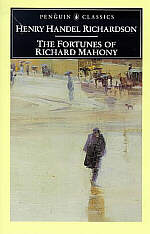 One prominent colonial doctor became the subject of great work
of literature! Walter Lindesay Richardson's daughter Florence
wrote about his life in her book the Fortunes
of Richard Mahony.
One prominent colonial doctor became the subject of great work
of literature! Walter Lindesay Richardson's daughter Florence
wrote about his life in her book the Fortunes
of Richard Mahony. |
|
PART THREE - COLONIAL MEDICAL TRANSPORT
|
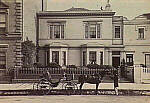 The
carriage of Dr. William Pugh, surgeon and oculist, outside his
house in Collins Street, Melbourne, in about 1865. With the
beautifully-presented horse, and the groom in attendance, this
form of transport was a luxury affordable only by the wealthy
specialist. Reproduced by courtesy
of the La Trobe Picture Collection, State Library of Victoria The
carriage of Dr. William Pugh, surgeon and oculist, outside his
house in Collins Street, Melbourne, in about 1865. With the
beautifully-presented horse, and the groom in attendance, this
form of transport was a luxury affordable only by the wealthy
specialist. Reproduced by courtesy
of the La Trobe Picture Collection, State Library of Victoria
|
 Colonial medical transport. Dr. Kelly outside his surgey in
Gulgong NSW (1870)
Colonial medical transport. Dr. Kelly outside his surgey in
Gulgong NSW (1870)
Reproduced by courtesy of the
Mitchell Library, State Library of New South Wales |
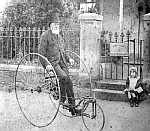 Colonial medical transport. Dr. S. R. Robinson adopted this
modern mode of transport when most of his colleagues still
kept horses and buggies.
Colonial medical transport. Dr. S. R. Robinson adopted this
modern mode of transport when most of his colleagues still
kept horses and buggies.
Reproduced by courtesy of the Geelong
Historical Records Centre
|
|
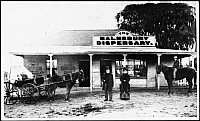 The
arrival of the familiar "horse and buggy" often
heralded the doctor's visit in colonial times. This photograph
shows Dr. Edward Davy and his wife, with their horse and buggy,
outside the Malmsbury Dispensary (taken in about 1870). The
arrival of the familiar "horse and buggy" often
heralded the doctor's visit in colonial times. This photograph
shows Dr. Edward Davy and his wife, with their horse and buggy,
outside the Malmsbury Dispensary (taken in about 1870).
Reproduced by courtesy of the La
Trobe Picture Collection, State Library of Victoria
|
